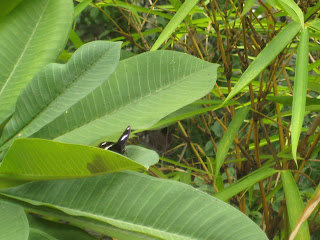 |
The van screeches to a halt in front of a long bridge, drops us off and promises to return to collect us on our departure. We get down, drag our bags noisily over the bridge and enter the visitors' information area. There is a wooden counter in front and before long, someone materializes and beckons. It is a young and efficient lady. She gives us a set of brochures and maps, snaps little paper visitor bracelets onto our wrists which indicate our day of departure and explains about possible expeditions. We make our payments, leave our luggage in our rooms and head for lunch.
The Gunung Mulu National Park lies sprawled all round us. We are still to get used to the foliage, the insects, the incessant jungle noises. There is life, sound and colour at every step.
Before our eyes, the sky starts clouding up. Large grey balls of water vapour glide in effortlessly, seemingly from nowhere.
It has been a long morning and we tuck in, gratefully.
 |
After a little nap, we contemplate stretching our legs and getting a feel for the place. Immediately there is a roll of thunder,followed by sheets and sheets of rain. We sit on the wooden verandah, watching the rain, sipping tea and waiting for the weather to clear. We sit for three hours, waiting. It doesn't really matter, for we are on holiday. We see people rushing to and fro, completely drenched, but we are not quite ready for this as yet. The air feels cool after the heat of Singapore. The rain gradually lessens, we grab our umbrellas and run towards the cafeteria. It is now dinner time and though we haven't done anything so far, we are hungry once more.
After dinner, we walk into the store next to the cafeteria. This sells basic food (snacks, chocolate, rice and a few cans) for camping, some local clothes, rain ponchos and T-shirts, postcards, handicrafts and books. They also sell wi-fi cards, in twelve hour slots. Each of us heads to a different section. My husband checks the wi-fi, our friend Madhu looks at the sharp local knives that can slash small branches (and undoubtedly other objects as well) to shreds in seconds and I gaze at the books. There I find 'The Orchid Seekers of Borneo' - an adventure story first published in 1893, written by Ashmore Russan and Frederick Boyle. It has been recently reprinted by the Natural History Publications (Borneo). I read the introductory note (see footnote) and I am entranced. I can't wait to read more - and to venture deep into the forest, looking for orchids (amongst other things). When we return to our rooms, I sit in bed and read a few pages before dropping off to sleep. Tomorrow we go into the forest, up into the limestone caves, beyond the river. Tomorrow...
Footnote: I quote, from the introductory note:
"Some of our boy readers may cry, on seeing the names of the two authors on the title page, "What! A couple of 'em?" And at any point they will be likely to ask themselves, "Now, I wonder which of the two wrote this?"
The public in such cases is commonly left to wonder, but circumstances here are unusual. When Mr. Ashmore Russan formed a project of writing a story upon the subject of orchid-collecting for the Boys' Own Paper, he applied to Messrs. Sander, of St. Albans, the great importers of orchids, for special information. They referred him to Mr. Frederick Boyle, as one who had travelled in many lands where those plants flourish, who grows them, as an amateur, with unusual success and publishes much about them. Mr. Boyle had no time to take an equal part in writing the story, but he consented to advise, direct, and in general to lend his assistance. The outline of the tale is his, and for all statements therein, historical, local or scientific, Mr. Boyle is responsible. It naturally happened, since he was treating of scenes he had himself beheld, of peoples and individuals he had himself known, that he found it necessary to take the pen from Mr. Russan's hand and write a few lines here and there. But in general he confined himself to his functions of director and critic. It will be understood, after this explanation, that the tale rests on a solid basis of fact all through."













































